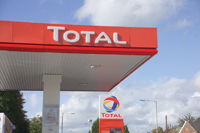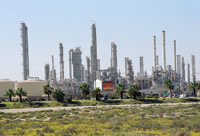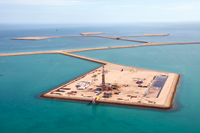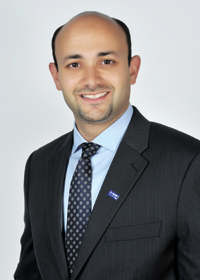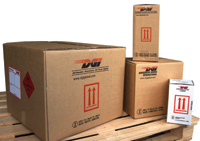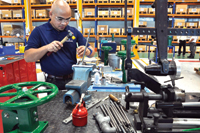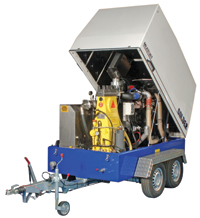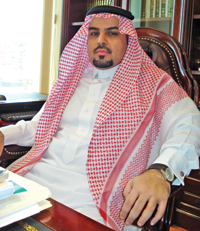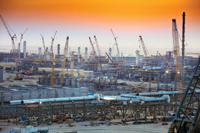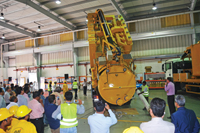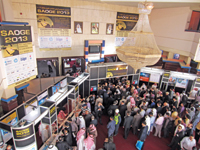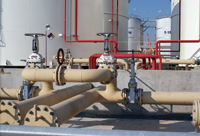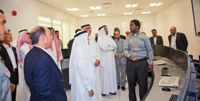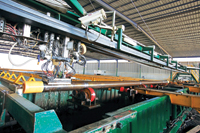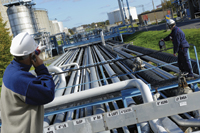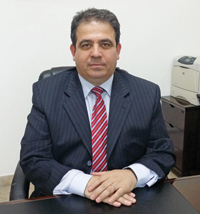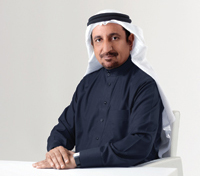
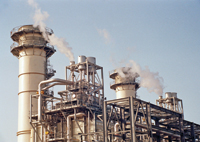 Jubail ... home to multifarious industries
Jubail ... home to multifarious industries
THE Royal Commission for Jubail and Yanbu (RCJY) has pumped more than SR900 billion ($240 billion) into the industrial cities of Jubail and Yanbu, the investments being directed to set up more than 600 plants to produce some 92 basic products.
RCJY has attracted investments estimated at SR142 billion for Jubail 2 project, with a number of specialised industries in the new project reaching some 16 industries, including industrial complexes for the production of petrochemicals and its derivatives such as Saudi Aramco and Total Refining and Petrochemical Co, which is aimed to produce 400,000 barrels of refined products per day, RCJY chairman Prince Saud bin Abdullah bin Thunayan says.
RCJY has also attracted investments estimated at SR11.72 billion for Yanbu Project 2 to produce titanium dioxide, reinforced iron in its different forms and solar-related industries, lubricating and motor oils, he points out.
“With this expansion, the number of residents of the cities of Jubail and Yanbu grew to 300,000 people,” he says.
He says the number of workers in the two cities in all sectors reached 175,000, while the number of students in public schools and academic institution affiliated to the RCJY stood at 70,000 students.
The RCJY share to the gross domestic product (GDP) stands at 12 per cent while its share to the industrial sector is 65 per cent, or two-thirds of the total industrial sector, he says.
The volume of RCJY exports from the two industrial cities form 85 per cent of the Saudi total nonoil exports, he notes.
Stemming from these achievements, the kingdom ranked 10th globally among the biggest producing countries for petroleum products, he says.
The Saudi Arabian authorities have signed five contracts worth $300 million to build infrastructure facilities in the industrial cities of Yanbu, Jubail and Ras Al Khair.
Among the contracts is a deal to build a security system for Jubail-2, while another will see the construction of roads, water and sewage networks for Ras Al Khair.
The Royal Commission’s CEO Dr Mosleh Hamed Al Otaibi says the level of private sector investment in Jubail Industrial City II, which was only established in 2006, has reached more than $111 billion (SR416.3 billion).
“These considerable achievements have made the kingdom the 10th largest producers of oil byproducts and the 7th largest producers of petrochemicals. For the latter, the kingdom accounts for 8 per cent of the petrochemical volume in global markets,” Prince Saud says.
Meanwhile, RCJY intends to invest SR67.5 billion to double its industrial area by 2030, attracting more industrial and commercial investments and manpower in parallel with the expansion of its residential area, which will provide 50,000 residential units and establish a new university for the Royal Commission (RC) in 2026.
The value of the implemented and under-construction projects in Jubail and Yanbu industrial cites has reached SR327 billion.
It’s been four years since the first edition of Jubail City Planning Forum was conducted in 2010 in Jubail Industrial City with the support of the Royal Commission (RC) for Jubail and Yanbu.
 |
Prince Saud ... leading the expansion of the |
The countdown of the second edition has already begun with Ahmed Al Balawi, chairman of the organising committee and general manager of technical affairs in the Royal Commission (RC) in Jubail, explaining the need for exchanging experiences and to get exposed to the latest trends and directions on city planning.
“We have almost completed Jubail 2 development and we have received interest from investors in getting lands and this has put some pressure on the residential areas development,” he says.
Currently, he says: “We are in the final stage of completing the Jalmoudah residential district. Land has been allocated to all beneficiaries from industries and they are working very hard to build houses for their employees. Work is also on track at the new Al Matrafiah residential district and in Mardumah.” Al Balawi says each of these districts would have an average population of 50,000 and an average of 8,000 to 10,000 units.
“We are in a very advance stage of development for Al Matraifiah. We have already allocated land for companies such as Saudi Aramco, Saudi Basic Industries Corporation (Sabic), Maaden and Al Sahra, and other industries have started developing their units,” Al Balawi says.
“For the last 35 years we have developed only two districts (Al Fanateer and Al Deffi) so this can give an idea about the magnitude of work within the RC,” he adds.
In addition, RC has started the planning of the fourth district Al Reggah.
“The demand that we forecast for the units between now and 2030 is 30,000 units and it will double up what we have now, the population is forecasted to reach 300,000,” Al Balawi says.
He adds: “50 per cent of investments in Jubail are international so it has a lot of international investors either investing directly or joining with major players such as Sabic and Saudi Aramco and from Europe, Japan and the US.
According to him, Jubail is a good Saudi model for providing infrastructure and a good platform for investment. Also, most of the government agencies send their delegates to Jubail for both study and business.
Work has lately begun on key initiatives at Jubail including expansions at the Saudi Arabian Fertiliser Company, the Natural Gas Company and the steel firm Hadeed.
Construction has also commenced on a complex of Saudi Kayan Petrochemicals and a project to make industrial rubber in Saudi Jubail Petrochemical Company (Kemya) as well as on a project of Arabian Petrochemical Company (Petrokemya). Additionally a polyoxymethylene plant is being built at the National Methanol Company (Ibn Sina).
In Yanbu, in the latest wave, ground breaking has taken place for a project of Arabian Industrial Fibres Company (Ibn Rushd).
Meanwhile, the Royal Commission plans to construct two PlasChem parks in each of the two cities to provide industrial services such as products packaging to all new refineries, petrochemical, and downstream plants to be built in their vicinities. They also aim to attract plastic downstream conversion industries including chemical manufacturers and to provide common services and facilities.
World markets are awaiting the construction of 26 plants that will produce more than 3 million tonnes of petrochemicals at the iconic complex of Sadara Chemical Company, a joint venture between Dow and Saudi Aramco. The first production units will be ready in H2 2015.
On a more modest scale, Sahara Petrochemicals Company, an affiliate of Tasnee and Sahara Olefins Company and the Saudi Acrylic Acid Company, has signed a contract with Daelim for a butanol plant that will have capacity of 330,000 tonnes annually of n-butanol and 11,000 metric tonnes of iso-butanol in Jubail Industrial city.
The world’s largest carbon dioxide purification and liquefaction plant for Jubail United Petrochemical Company, a manufacturing affiliate of Sabic is to be built in Jubail.
Construction is generally complete of the 400,000 bpd full-conversion Saudi Aramco Total Refinery & Petrochemicals Co (Satorp) refinery at Jubail. It is expected that all units will be in operation by November. The refinery will process Arab heavy crude and yield petrochemicals as well as high-quality fuels. It is Saudi Arabia’s first producer of petroleum coke and paraxylene.
Earlier this year, Sabic opened its first engineering thermoplastics compounding facility as well as a new polypropylene compounding (PPc) plant at its manufacturing affiliate, Saudi Speciality Chemicals Company in Jubail.
 |
Sinopec ... teaming up with Saudi Aramco |
The figures surrounding Jubail Industrial City are staggering. The city, which has sprung up from an area of Saudi Arabia’s Eastern Province that contained a fishing village less than 40 years ago, is now responsible for around 7 per cent of Saudi Arabia’s GDP. Add in the economic output of its western coast twin city of Yanbu, and they are not only responsible for 12 per cent of GDP, but also two-thirds of the kingdom’s entire industrial production.
What’s more, Jubail is growing at a phenomenal rate. A new mega-refinery, Satorp, which is nearing completion, sits on a site of more than 4 sq km and has cost an estimated $14 billion to build. The project, which is a joint venture between Saudi Aramco (which has a 62.5 per cent stake) and France’s Total (37.5 per cent), is currently in experimental production phase, with the first refined products from the plant being shipped via huge lines directly to the nearby King Fahad Port in September.
The refinery, which is capable of processing 400,000 barrels of oil per day into petrol, diesel, jet fuel and a variety of other useful products, would be a major standalone asset in most countries.
In Jubail, however, it is merely one of four phases of Jubail Industrial City II – a massive site that only began to be built in 2006. And it isn’t even the largest part. It is being followed by a new downstream chemicals complex containing 26 different manufacturing units that is costing $19.3 billion to develop.
The Jubail RC has followed a unique planning philosophy in its new housing neighbourhoods, which is based on the latest international planning trends in the world starting with selecting the appropriate location away from the industrial area, placing a buffer area for it and redirecting the houses to be opposite to the prevailing wind.
The design is based on creating extended green spaces and the gradual provision of essential services to these neighbourhoods.
The design also relates to building housing blocks that depend on the separation of traffic from pedestrians as much as possible, which strives to achieve principles of sustainability in urban design and take advantage of the ancient Islamic architecture by employing its ideas and patterns in architecture.
On the functional side, the RC was keen on the residential area being built on a solid foundation of complete infrastructure, where beneath these neighborhoods there is another harmonious beautiful city consisting of services’ corridors that were carefully crafted according to the best international standards.
All these are meant to ensure that the residents enjoy an integrated urban environment that fulfills all their wishes and needs.
“We hope this forum will give all the participants and all attendees a good opportunity to see what other people are doing, and to exchange experiences and carry some of them back home,” Al Balawi adds.
Meanwhile at Yanbu, Saudi Aramco Lubricating Oil Refining Company (Luberef) is expanding its Yanbu refinery to enhance the base oil product and meet the growing demand of high-quality GR-II and GR-III base oils. US-based Jacobs Engineering Group is providing project management. Luberef, a joint venture between Saudi Aramco and Jadwa Industrial Investment, is one of the world’s leading suppliers of high-quality base oil.
Chinese Petrochemical Corporation Sinopec has teamed up with Saudi Aramco for a refinery project at Yanbu called Yasref. Sinopec will hold a 37.5 per cent share in Yasref with Aramco holding the remaining 62.5 per cent.
The refinery, scheduled to be operational in the second half of 2014, will process 400,000 bpd of Arabian heavy crude oil and produce high-quality transportation fuels that meet the most stringent refined product specifications for domestic and international markets. Saudi Aramco’s extensive and integrated hydrocarbon facilities in Yanbu will be utilised to supply crude oil feedstock to Yasref and to export transportation fuels.
Siimco, the Saudi International Insulation Manufacturing Company, a joint venture equally owned by Alghanim Industries and Saint-Gobain, has leased a 65,000 sq m site at Yanbu to develop a plant to make stone wool.



















































































